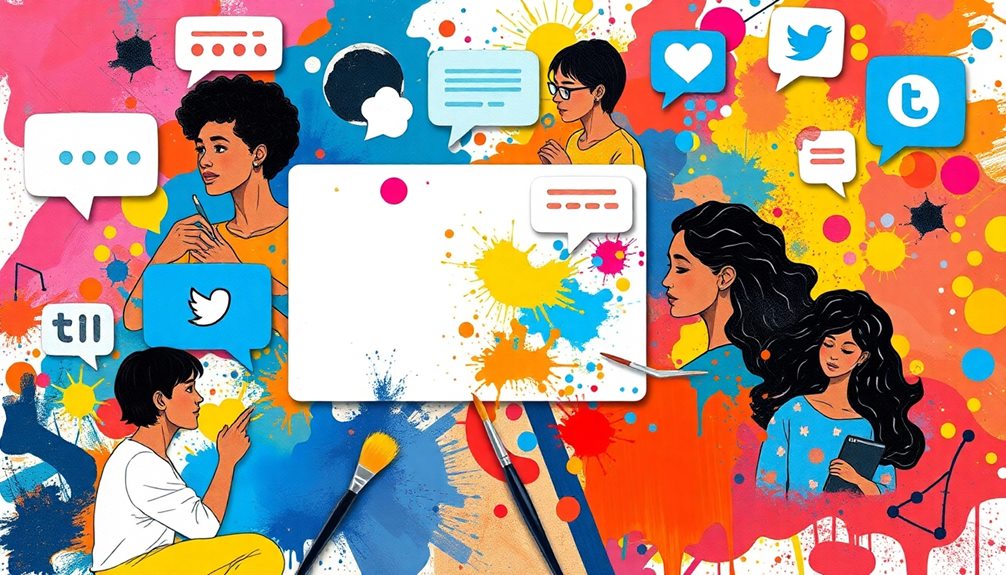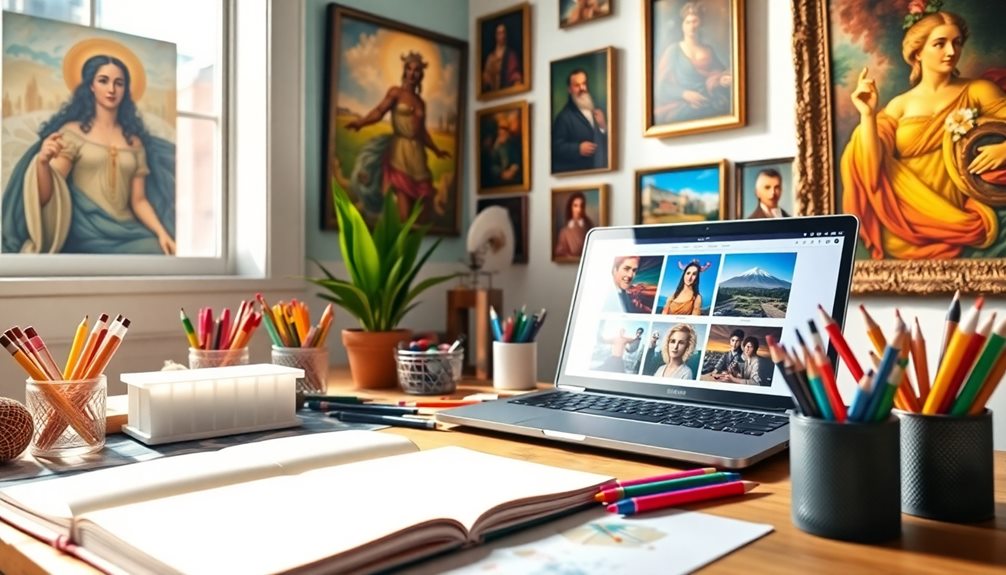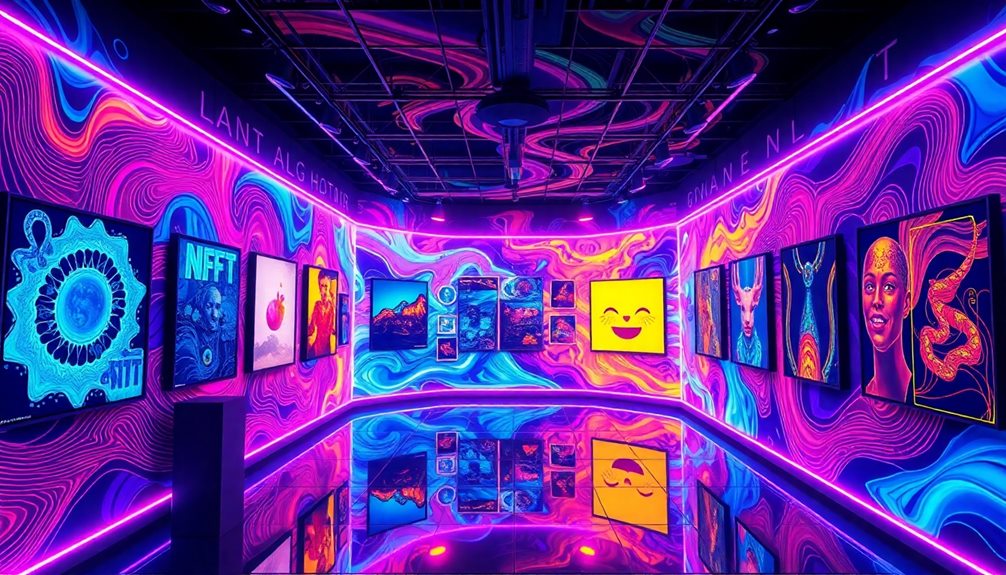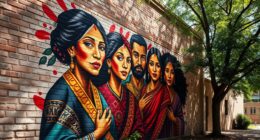Social media transforms the art landscape, providing you with a platform to showcase your work globally. You can connect with diverse artists and audiences, gaining visibility and recognition. While hashtags help street art go viral, the pressure to create shareable content can sometimes stifle your unique voice. You'll find that trends shape artistic expression, yet they also risk overshadowing authenticity. It's a balancing act of staying true to your vision while engaging with your audience. As you explore this dynamic, you'll uncover more about how social media continues to redefine artistic boundaries and community engagement.
Key Takeaways
- Social media enhances visibility for artists, with 67% reporting increased recognition through platforms like Instagram.
- The pressure for shareable content can stifle unique artistic voices and originality.
- Online art communities foster connections, collaboration, and feedback, enriching artistic expression and skill development.
- Commercialization of art spaces often shifts focus from community narratives to market-driven messages, impacting authenticity.
- Viral trends on social media can encourage conformity in styles, challenging individual artistic identities.
Influence on Artistic Expression

Through social media, artists are redefining their creative expression in ways we've never seen before. Social media platforms, especially Instagram, have become essential for artists like you to showcase your work. With 67% of artists reporting increased visibility and recognition, these platforms serve as a launchpad for your artistic journey.
Street artists, in particular, have harnessed the power of hashtags and location tagging, allowing their creations to go viral and reach audiences worldwide. This rapid dissemination of art increases engagement and transforms how people experience creativity.
However, the quest for shareable content can also stifle your artistic voice. The pressure to conform to trends may lead you to prioritize what's popular over your unique expression.
Artists like Yayoi Kusama exemplify how to navigate this landscape effectively, using immersive installations to draw millions into their creative world. By blending art and social media, they not only attract attention but redefine how art is experienced.
Ultimately, while social media offers incredible opportunities for visibility, it also challenges you to maintain your authenticity amid the noise. Balancing these factors can reshape your approach to artistic expression in profound ways.
Evolution of Art and Technology

Art and technology have evolved hand in hand, with social media playing a pivotal role in this transformation. Today, artists can share their work with global audiences without needing traditional galleries, fundamentally changing the art world. Platforms like Instagram and Pinterest redefine how you create and curate art, pushing you to adapt your work for better visibility in a fast-scrolling environment.
| Aspect | Impact on Artists |
|---|---|
| Exposure | Reach wider audiences without galleries |
| Creation Process | Adapt work for social media formatting |
| Art Education | Access online tutorials democratizes learning |
| Trends | Viral trends encourage conformity |
| Originality | Homogenization of styles impacts unique expression |
As you navigate these changes, you'll notice how social media's specific formatting standards influence your compositional choices. Furthermore, the accessibility of resources empowers emerging artists, promoting skill enhancement and exploration of different mediums. However, the prevalence of trends may pressure you to conform to popular aesthetics, affecting originality in the art world.
Commercialization of Artistic Spaces

The commercialization of artistic spaces has transformed how you experience and interact with art in public settings. Today, murals and installations often serve as guerrilla marketing tools, driven by the pressures of social media posts. For example, iconic spots like Paul Smith's pink wall in Los Angeles attract visitors seeking the perfect selfie, turning art into an advertising medium without their conscious awareness.
This trend has given rise to "Instagrammable" art, where the diversity of artistic expression can feel diluted. Street artists, like iHeart, may find themselves conforming to popular trends that align more with commercial interests than their authentic vision.
As you navigate these spaces, you might notice that street art increasingly shifts from community-focused narratives to commercialized messages designed to attract brand partnerships and sponsorships.
These changes raise significant questions about the authenticity and value of art. As the original intent of artistic creations gets overshadowed by marketing demands, you're left wondering whether the beauty and meaning of art remain intact in this new landscape of commercialization.
The intersection of art and commerce continues to challenge your perception of what art truly represents.
Engagement and Community Building

Social media has revolutionized how you engage with art and build community. Platforms like Instagram and Facebook have created vibrant online art communities, bridging the gap between artists from various backgrounds. You can now connect with fellow creators, share your experiences, and foster meaningful relationships, making the art world feel more accessible than ever.
The dynamics of artistic practice and public engagement have evolved, as artists utilize these platforms to reach wider audiences and receive invaluable feedback on their work, reflecting the growing importance of community collaboration in art projects impact of sustainable materials.
These media channels offer a lifeline for isolated artists, enhancing collaboration and allowing you to share both triumphs and challenges with peers. When you post your art, you can effectively reach potential clients while building a dedicated fanbase. Engagement metrics, such as likes and shares, provide immediate feedback, creating a sense of community where support flows freely.
Additionally, social media facilitates networking and collaboration among artists, which can greatly enhance your skill development. Access to tutorials, resources, and virtual workshops allows you to learn from others and share your own knowledge.
Cultural Reflection Through Art

As you explore the vibrant connections fostered through social media, it's impossible to ignore how these platforms also reflect and shape cultural values. Social media serves as a cultural mirror, revealing themes of vanity and connection in contemporary society. Artists like iHeart critique this phenomenon, using their work to comment on social interactions and community dynamics.
| Theme | Example | Reflection |
|---|---|---|
| Superficiality | Art-selfies | Blurs appreciation and promotion |
| Youth Interaction | Street art critiques | Highlights social commentary |
| Authenticity | Digital engagement | Raises philosophical questions |
| Consumption Trends | Likes and shares | Challenges true intent |
The impact of social media on art is profound; you see creators maneuvering expectations while trying to create art that resonates. These platforms encourage new connections but also prompt discussions about privacy policy and the implications of sharing art online. Ultimately, art on social media becomes a commentary on the nature of engagement, questioning whether it's genuine appreciation or merely self-promotion.
Navigating Challenges and Opportunities

Steering through the world of social media means finding the right balance between authenticity and current trends.
You can build a strong community around your art, but it's crucial to stay true to your vision while also engaging with what's popular.
This journey involves not just showcasing your work, but also understanding how to connect meaningfully with your audience.
Balancing Authenticity and Trends
In today's art world, artists often juggle the pressure to conform to social media trends with the desire to maintain their authentic creative vision. The demand for likes and shares can lead you to prioritize marketable content over personal expression.
With the rise of viral art trends on platforms like Instagram, originality can get stifled as you may feel pushed to adopt popular aesthetics instead of exploring your unique style. Inspiring success stories reveal that embracing your personal journey can strengthen your artistic identity and attract a more genuine audience.
Moreover, social media algorithms favor specific visual themes, compelling you to navigate these dynamics while trying to keep your artistic integrity intact.
Many artists report feeling pressured to produce content more frequently, which can lead to burnout and a decline in the quality of their work. This money-driven approach can threaten your ability to create well-known pieces that resonate with your audience.
To foster authenticity, consider curating your social media presence by sharing personal stories and insights into your creative process.
Doing this can help you engage genuinely with your audience, allowing you to transcend mere trend-following while still capturing their attention span. Balancing authenticity and trends is challenging, but it's essential for sustaining your artistic voice.
Community Building Opportunities
Many artists discover that social media offers incredible community-building opportunities, connecting them with like-minded individuals and fostering a sense of belonging. Through various online art communities, you can engage with peers globally, breaking the isolation that often comes with the artistic journey.
These platforms allow you to showcase your work to a wider audience, effectively building your fanbase and enhancing your networking without relying solely on traditional gallery representation. Additionally, as you engage with these communities, you may find inspiration from diverse perspectives, enhancing your creativity and artistic expression through shared experiences and insights on vibrational alignment with youthfulness and liveliness.
Social media also facilitates collaboration, enabling joint projects and exhibitions that enrich your creative practice. You'll find that sharing resources, tutorials, and mentorship opportunities are abundant, helping you sharpen your skills and broaden your artistic horizons.
This interconnected practice of social engagement encourages community-building among artists and supporters alike, leading to a more supportive arts ecosystem.
As you navigate these community building opportunities, remember that the connections you make can considerably impact your career. Embrace the chance to interact with others, share your triumphs and challenges, and contribute to a vibrant, engaging dialogue within the art world.
Frequently Asked Questions
How Does Social Media Affect the Arts?
Social media amplifies your visibility as an artist, connects you with a wider audience, and offers networking opportunities. However, it can also pressure you to conform to trends, impacting your creativity and authenticity.
How Have the Social Media Helped in Making Each Art Form?
Imagine a garden where each flower blooms uniquely; social media's your sunlight. It nurtures diverse art forms, allowing you to share, learn, and connect, transforming your creative expressions into vibrant displays for a global audience.
What Are the Disadvantages of Social Media for Artists?
You might feel overwhelmed by the pressure to post constantly, face harsh criticisms that stifle your creativity, and worry about protecting your work from theft, all while maneuvering an oversaturated landscape that undervalues your art.
What Is the Social Impact of Art?
Art influences society by sparking conversations and challenging perceptions. It encourages you to reflect on your experiences and beliefs, fostering empathy and understanding. Through art, you connect with others and inspire change in your community.
Conclusion
You might think social media diminishes the authenticity of art, but it actually amplifies diverse voices and ideas. By connecting artists and audiences globally, it fosters creativity and collaboration in ways we've never seen before. Embracing this digital revolution enriches your experience as an art lover, allowing you to engage with fresh perspectives and emerging talents. So, instead of resisting change, let's celebrate how social media transforms art into a vibrant, communal journey.









